It’s no secret that my favourite film is Dangerous Liaisons. Released in 1988 – and starring Glenn Close, John Malkovich, Michelle Pfeiffer and a very young Uma Thurman – after seeing this film during an English lesson at school, I became a little bit obsessed.
The film of the play, based on an 18th Century Novel
Dangerous Liaisons is based on the play Les Liaisons Dangereuse by Christopher Hampton. The play is itself adapted from an 18th Century novel of the same name by Pierre Choderlos de Laclos.
Published in 1782 and purported to be inspired by stories told to the young de Laclos by a very ugly, old woman with a fondness for walnuts, Les Liaisons Dangereuse is a tale of high society boredom and debauchery amongst the Parisian elite.
The narrative unfolds through a series of letters between the Marquise de Merteuil and her ex-lover the Vicomte de Valmont, as they scheme to seduce and corrupt a number of innocent and virtuous young women. I’ll not spoil the plot further. If you haven’t already seen the film, then go and watch it – now!
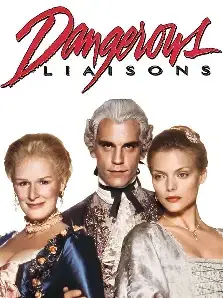
Dangerous Liaisons (1988) - starring
Glenn Close, John Malkovich
and
Michelle Pfeiffer
Having read the source material, the script sticks closely to the original story. De Laclos was a feminist writer, who advocated for education for girls (not a particularly popular stance at the time). He puts his female characters at the heart of the story, and the film allows them to be of their time, not weighed down with inserted modern sensibilities – so fashionable nowadays. And the film’s all the better for it. Nor are all the women weak and feeble, just waiting to be ruined – or rescued – by the male characters.
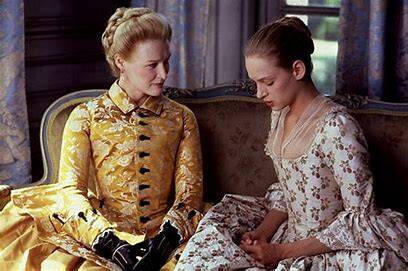
Glenn Close as the Marquise de Merteuil
and
Uma Thurman as Cécile de Volanges
I’ll be honest, I’m not that enamoured of 18th Century history – or its fashions. But this film is so well realised I instantly fell in love with it. It looks simply gorgeous. Filmed on location in France, beautifully dressed actors swan around opulently grandiose chateaux, accompanied by a soundtrack right out of the period. The film was nominated for – and won – several prestigious awards, including an Oscar for best costumes. It would have been a travesty if it hadn’t have won.
The story is entirely domestic and, therefore, feminine. Nothing of the political life of 18th Century France is allowed to impinge on the lives of these leisured upper-class ladies, who visit each other to drink tea, play cards, patronise the opera and do charitable works for those less fortunate than themselves. Thank goodness then for the Marquise de Merteuil and her partner in crime the Vicomte de Valmont, who insert some intrigue, nastiness and sleaze into this cozy, privileged little world.
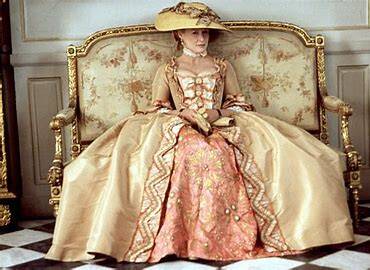
The Marquise de Merteuil (Glenn Close) in all her glory
This is undoubtably Glenn Close's film as the vain, manipulative, and arrogant (although outwardly respectable) Marquise, and we get to see events unfold mainly through her gaze. I think it also helps that Glenn Close is probably the least pretty of the actresses, her undoubted attraction being down to her wit and spirit, not just her physical charms. And she gets all the best dresses – which helps.
It’s interesting that most of the main cast were not known for playing period parts at the time. The one quibble I have is the American accents of the leads, which can be somewhat grating, whilst bizarrely, all the servants and lower-class bit parts are Scottish (including a young Peter Capaldi).
The film has the perfect opening – as we watch as the Marquise and Valmont are made ready to meet the world by a small army of servants. This includes being sewn into a gown and adjustment of the internal lining of the Marquise’s robe de la Francais, and nasal hair plucking and powdering the Vicomte’s wig. I love all these fascinating little details.
This production sets itself a few decades before the 1780s in which the original novel was published – somewhere in the 1760’s, if I’m any judge. Think Madame de Pompadour not Maire Antoinette. And I’m thankful for that. There’s extravagance, but it’s not yet over the top.
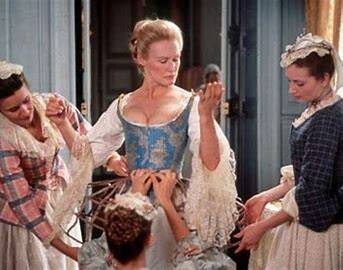
The Marquise at her toilette

Glenn Close wearing a beautifully recreated robe a la Francais or sack backed gown - fashionable between 1740 and 1780.
The costumes were designed by James Ascheson, whose other work has included classic episodes of the BBC’s Doctor Who, working with the director Terry Gillingham on films ‘Time Bandits’ and ‘Brazil’, and winning more Oscars with costumes for ‘The Last Emperor’ and ‘Restoration’. The total budget for the entire production was only $14 million, and that allocated for costumes considerably less – but you’d never know.
It's interesting to compare Dangerous Liaisons with ‘Valmont’ (directed by Milos Foreman), based on the same 18th Century novel and being shot at the same time, with a considerably bigger budget and longer shooting schedule. Colin Firth portrays the Vicomte de Valmont this time, and the much prettier Annette Benning the Marquise de Merteuil. There are several deviations from the original plot, although this version is closer to its 1780s setting costume wise. However, this more expensive telling of the tale somehow ended up looking rather cheap in comparison. As much as my teeth are set on edge by the accents in ‘Dangerous Liaisons’, at least they are consistent. In ‘Valmont’, we get a mixture of American and crystalline British dialects, the latter showing the former up something chronic.
But back to our version of the story, and its costumes. I’m in no way an expert in 18th Century fashion, but I think I have a good idea of the overall styles and silhouettes which were being worn. And nothing to my eye looks out of place or wrong. I know there are those who know better who have quibbles about court gowns being worn to the opera, and the odd back lacing gown. Even the ladies’ hair is worn up and an effort has been made to dress it in appropriate 18th Century styles, and the make-up is also subtle and natural looking. Hair and makeup are usually the two things that betray when a period movie was actually made, as actresses and design teams seem reluctant to give up trendy slap and ‘dos, although they are the things which will date the production in the future.
It’s hard to pick a favourite costume from this film, but I will limit myself to two, both worn by Glenn Close as the Marquise de Merteuil. The very dark petrol blue/green satin gown trimmed with delicate little pink rosebuds is surely an interpretation of that worn by Madame de Pompadour in one of her many portraits.
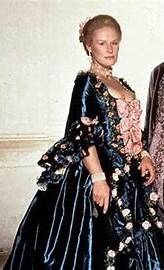
Glenn Close as the
Marquise de Merteuil (left)
and
Madame de Pompadour
by
Francois Boucher - 1756 (right)

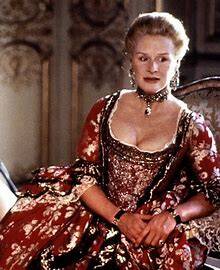
Every villainess needs a fabulous red dress!
And the dark red brocade gown worn in many of Close’s final scenes in the film is to die for. It has been noted that such dark colours weren’t very fashionable during the 18th century, which is famous for its subtle pastel shades. But I think these costume choices are perfect for the Marquise’s character.
And the men's costumes aren't bad either.

John Malkovich as the Vicomte de Valmont
If you’ve not succumbed yet, but fancy giving Dangerous Liaisons a go, one final warning – this is not some chintzy Jane Austen romance. It’s pretty spicy, with strong sexual themes and a smattering of nudity, although tastefully done.
What’s your favourite historical drama? I’d love to know.
Add comment
Comments